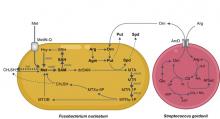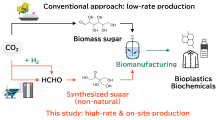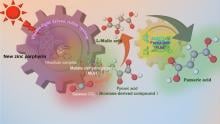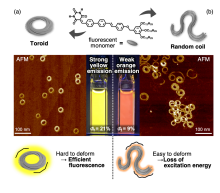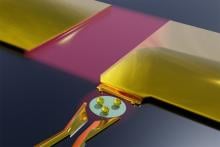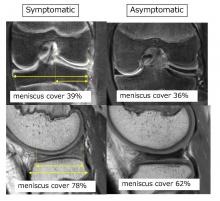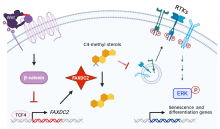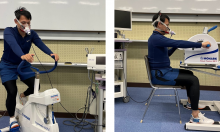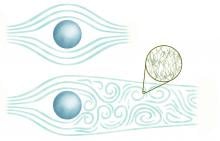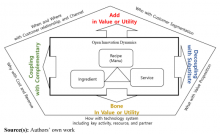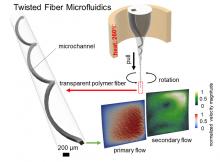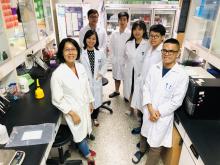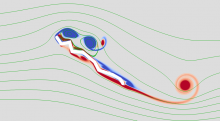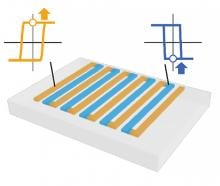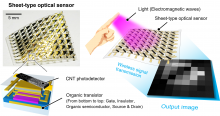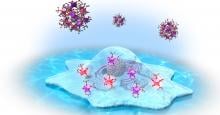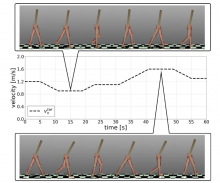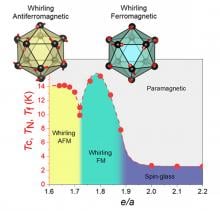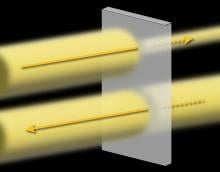Peer Reviewed
News
15 Feb 2024
Researchers from Osaka University found that the oral bacterium Streptococcus gordonii activates another bacterial species, Fusobacterium nucleatum, to produce large quantities of methyl mercaptan, a compound responsible for bad breath. Disrupting this interaction could therefore help treat halitosis, and possibly also help prevent the development of more serious tooth and gum disease.
14 Feb 2024
Researchers from Osaka University and collaborating partners succeeded in biomanufacturing from chemically synthesized sugar for the first time in the world. With refinement of this technology, one can envision a future society in which the sugar required for biomanufacturing can be obtained "anytime, anywhere, and at high rate". In the future, biomanufacturing using chemically synthesized sugar is expected to be a game changer in the biotechnology field—including the production of biochemicals, biofuels, and food, where sugar is an essential raw material—ultimately leading to the creation of a new bio-industry.
14 Feb 2024
An innovative and more efficient way to produce fumaric acid that not only reduces carbon dioxide emissions, but also reuses waste resources to make biodegradable plastics
14 Feb 2024
Researchers from Osaka University have found that gargling with an antiseptic mouthwash can reduce so-called ‘bad’ bacteria in the mouths of patients with type 2 diabetes. Notably, this reduction in bacteria was accompanied by improved blood-sugar control in some patients. Given that the oral diseases caused by these bacteria have been linked to many other serious inflammation-associated diseases, such as cardiovascular disease and Alzheimer’s disease, this simple treatment may have widespread effects.
13 Feb 2024
The properties of supramolecular polymers are dictated by the self-assembled state of the molecules. However, not much is known about the impact of morphologies on the properties of nano- and mesoscopic-scale polymeric assemblies. Recently, a research team demonstrated how terminus-free toroids and random coils derived from the same luminescent molecule show different photophysical properties. The team also presented a novel method for purifying the toroidal structure.
13 Feb 2024
Researchers from the Institute of Industrial Science, The University of Tokyo have solved a foundational problem in transmitting quantum information, which could dramatically enhance the utility of integrated circuits and quantum computing.
07 Feb 2024
Elucidating why some patients with specific joint deformities are symptomatic while others are not
05 Feb 2024
A key innovation in photonic (light-driven) microelectromechanical components could transform computing technology, increasing efficiency while reducing power consumption and chip size.
02 Feb 2024
A study led by Duke-NUS Medical School has found an important connection between cancer, stem cells and the building blocks of cholesterol. Specifically, the research reveals how the enzyme FAXDC2 influences cancer cell growth and differentiation through its role in cholesterol synthesis, suggesting possible new approaches to cancer treatment.
01 Feb 2024
Theoretical predictions have been confirmed with the discovery of an outflow of molecular gas from a quasar when the Universe was less than a billion years old.
01 Feb 2024
Researchers from Osaka University and IMRA AMERICA demonstrated a 300 GHz-band wireless link that was able to transmit data over a single channel at a rate of 240 gigabits per second. The wireless communication system employs signal generators based on lasers that have ultra-low phase noise in the sub-terahertz band. This rate is the highest so far reported at these frequencies and is a substantial step forward in 300 GHz-band communications for 6G networks.
31 Jan 2024
Carbon nanostructures could become easier to design and synthesize thanks to a machine learning method that predicts how they grow on metal surfaces. The new approach, developed by researchers at Japan’s Tohoku University and China’s Shanghai Jiao Tong University, will make it easier to exploit the unique chemical versatility of carbon nanotechnology.
30 Jan 2024
A team of researchers from Osaka Metropolitan University assessed the feasibility of conducting cardiopulmonary exercise testing with the upper limbs as an alternative to the conventional method that uses the lower limbs. The researchers investigated the relationship between heart rate and oxygen uptake during exercise stress tests using a cycle ergometer and an arm crank ergometer, and estimated maximal oxygen uptake. The study participants were 17 male collegiate athletes from rowing and cycling clubs. The results showed that the estimated maximal oxygen uptake for both rowing and cycling groups was lower on the arm crank ergometer than on the cycle ergometer. Additionally, this study showed that exercise testing using an upper extremity ergometer underestimates cardiopulmonary function, regardless of upper limb training status.
29 Jan 2024
A new technology to increase visibility of cancer cells to the immune system using CRISPR has been developed, and could lead to a new way to treat cancer.
29 Jan 2024
A theoretical framework for measuring the Reynolds similitude in superfluids could help demonstrate the existence of quantum viscosity
26 Jan 2024
- DGIST Prof. Park Jin-hee and her team detected unknown sample components by analyzing color change patterns and developed a technology that allows analyzing concentrated amounts through a mobile phone camera
- Expected to secure source technologies and open new avenues in the environmental sensor field
26 Jan 2024
- DGIST’s Dr. Yun JinHyo and team have, jointly with research teams from Japan and Italy, found a path to sustained innovation in the service industry using business models.
- Findings have been published in the world-renowned European Journal of Innovation Management (EJIM, SSCI, Q2)
26 Jan 2024
A team of researchers have opened new possibilities in bioanalytical application by developing a microfluidic device that allows for the precise and efficient manipulation of fluids in three-dimensional microscale environments.
25 Jan 2024
Taiwan: Researchers from National Chung-Hsing University, Taiwan, have made a discovery in the fight against Zika virus. Their study, published in the journal “Communication Biology,” reveals that people who have previously been exposed to dengue virus and Japanese encephalitis virus may have acquired immunity against Zika virus. This finding may shed new light on vaccine strategies in countries where these viruses are common.
23 Jan 2024
Corrugated wings exhibit larger lift than flat wings
23 Jan 2024
Scientists are eager to harness the unique electrical properties of topological magnets for advancing thermoelectric materials. A collaborative research group has successfully induced positive and negative polarities, unlocking the potential for generating thermoelectric energy from materials with topological magnet properties.
23 Jan 2024
Researchers from SANKEN (The Institute of Scientific and Industrial Research), at Osaka University developed an optical sensor consisting of carbon nanotube photodetectors and organic transistors formed on an ultrathin, flexible polymer film. A wireless system reads the images from the sensor. Experiments showed the sensor has high sensitivity, a wide bandwidth, and robustness to extreme deformation such as bending and crumpling. This sensor has high potential for use in applications such as non-destructive imaging, non-sampling liquid quality evaluation, wearable devices, and soft robotics.
23 Jan 2024
The Hayabusa2 mission that collected samples from the asteroid Ryugu has provided a treasure trove of insights into our solar system. After analyzing samples further, a team of researchers have unearthed evidence that cometary organic matter was transported from space to the near-Earth region.
22 Jan 2024
Researchers from Thailand have pioneered the conversion of waste HDPE milk bottles into high-stiffness composites, utilizing PALF reinforcement for a 162% increase in flexural strength and 204% in modulus. This eco-friendly upcycling boosts mechanical properties while sequestering carbon, presenting a promising path for sustainable materials.
22 Jan 2024
A water-soluble, luminescent europium complex enables evaluation of malignancy grade in model glioma tumor cells.
22 Jan 2024
We may not think about it while doing it, but our nervous system is directing our bones, joints, muscles, tendons, and more to move as efficiently as possible at varying speeds. Replicating this in robots is notoriously difficult. But now, Tohoku University researchers have created a model that makes this possible, thanks in large part to an innovative algorithm.

19 Jan 2024
Temperature-controlled, reversible shifting of molecular gear motion in a solid crystal opens new possibilities for material design.
19 Jan 2024
A recent paper published in the journal Astronomy & Astrophysics presents new images from the 2018 data that reveal a familiar ring the same size as observed in 2017. This bright ring surrounds a deep central depression, “the shadow of the black hole,” as predicted by general relativity. Excitingly, the peak brightness of the ring has shifted by about 30º counter clockwise compared to its position in 2017, which is consistent with our theoretical understanding of the variability of the turbulent material around black holes.
18 Jan 2024
Non-Heisenberg-type approximant crystals have many interesting properties and are intriguing for researchers of condensed matter physics. However, their magnetic phase diagrams, which are crucial for realizing their potential, remain completely unknown. Now, for the first time, a team of researchers has constructed the magnetic phase diagram of a non-Heisenberg Tsai-type 1/1 gold-gallium-terbium approximant crystal. This development marks a significant step forward for quasicrystal research and for the realization of magnetic refrigerators and spintronic devices.
18 Jan 2024
A research group led by Osaka Metropolitan University has discovered significant nonreciprocal optical absorption of LiNiPO4, referred to as the optical diode effect, in which divalent nickel (Ni2+) ions are responsible for magnetism, by passing light at shortwave infrared wavelengths used in optical communications. Furthermore, they have uncovered that it is possible to switch the optical diode effect by applying a magnetic field. This is a step forward in the development of an innovative optical isolator that is more compact and can control light propagation, replacing the conventional optical isolators with complex structures
Events
Sorry, no events coming up for this topic.
Researchers
Sorry, no researchers coming up for this topic.
Giants in history
Sorry, no researchers coming up for this topic.


